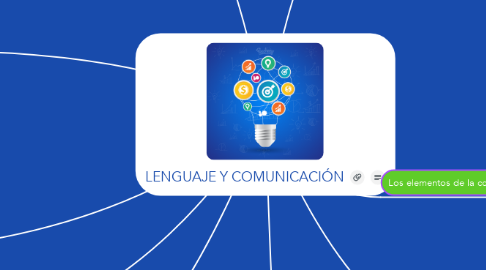
1. Que es la comunicacion
1.1. Es el proceso interactivo o interpersonal proceso, en cuanto se producen etapas e interactivo o interpersonal, porque ocurre entre personas y esta compuesto por elementos.
2. la comunicación oral y escrita,contemplan las otras manifestaciones del lenguaje.
2.1. Funciones del Lenguaje
2.2. Expresiva
2.3. Apelativa
2.4. conotativa
2.5. representativa o referencial
2.6. metalinguistica
2.7. Fatica y poética
3. El discurso se aplica en:
3.1. En la exposicion
3.2. narracion
3.3. argumentos de tema
3.4. temas especificos
4. El discurso
4.1. se refiere a las acciones sociales que llevan a cabo los usuarios del lenguaje cuando se comunican.
5. El concepto esquema
5.1. Esta relacionado con la red de escrituras conceptuales y metales que posse un individuo para poder realizar procesos como aprender.
6. Las funciones del lenguaje,han permitido hacer otras clasificaciones entre esta:
6.1. la funcion pragmatica
6.2. la funcion expresiva
6.3. la funsion apelativa
6.4. la funcion representativa
6.5. la funcion metalinguistica
6.6. funcio fatica
6.7. Lfuncion poetica
7. Los elementos de la comunicación son
7.1. El emisor
7.1.1. Situational Analysis / Drivers
7.1.1.1. What is driving us to do this?
7.1.1.2. SWOT Analysis
7.1.1.2.1. Strengths
7.1.1.2.2. Weaknesses
7.1.1.2.3. Opportunities
7.1.1.2.4. Threats
7.1.1.3. Customer Findings - What have we learned from customers?
7.1.2. Competitive Analysis
7.1.2.1. Do we have competitors and threats in these target markets with the proposed offerings?
7.1.2.2. What are our competitors doing and how are they positioning?
7.1.2.3. How do we position against each competitor?
7.1.3. Target Customer(s)
7.1.3.1. Buyer Profile
7.1.3.1.1. Title
7.1.3.1.2. Industry
7.1.3.1.3. Geography
7.1.3.1.4. Business Size
7.1.3.2. Influencer Profile
7.1.3.3. User Profile
7.1.3.4. What do customers want and need?
7.1.3.5. What business problems do each of these customers have?
7.1.4. Customer Segmentation
7.1.4.1. Which customers or sets of customers do we sell to?
7.1.4.2. What are the target market segments that we want to go after?
7.1.4.3. What are the distinct problems for each segment of the market?
7.1.5. Total Available Market
7.1.5.1. New Prospects
7.1.5.1.1. How much of each target segment have we penetrated?
7.1.5.1.2. How much opportunity is available in each target segment?
7.1.5.2. Existing Customers
7.1.5.2.1. Can we up-sell existing customers?
7.2. receptor
7.2.1. Service Offer
7.2.1.1. What are we selling?
7.2.1.2. Product Definition
7.2.1.3. Pricing
7.2.1.4. Packaging
7.2.1.5. Positioning
7.2.2. Value Proposition
7.2.2.1. What is the Value Proposition to the Customer?
7.2.2.2. What pain are we solving?
7.3. mensaje
7.3.1. Revenue Forecasts
7.3.1.1. Revenue and P&L Forecast (5 Years)
7.3.1.2. Revenue should be split out quarterly
7.3.2. Cost Analysis
7.3.2.1. Should include a description of the costs in entering this business and profitability analysis
7.3.3. Profitability Analysis
7.3.3.1. P&L for the offer to include gross margin, net income and break even analysis.
7.4. canal
7.4.1. Sales Strategy
7.4.1.1. Direct Sales Strategy
7.4.1.2. Inside Sales Strategy
7.4.1.3. Channel Sales Strategy
7.4.2. Partner Strategy
7.4.2.1. Channel Strategy
7.4.2.1.1. What 3rd party channels should we consider for reselling this service?
7.4.2.2. Technology Partnerships
7.4.2.2.1. What technology vendors (if any) do we need to work with to execute on this plan?
7.4.2.3. Solutions Partners
7.5. codigo
7.5.1. Positioning & Messaging
7.5.1.1. What is the key messaging and positioning for the service offer? (Pain, alternatives, solution)
7.5.1.2. How do we communicate internally?
7.5.1.3. How do we communicate externally?
7.5.2. Promotion Strategy
7.5.2.1. Marketing Programs (Installed base versus new prospects)
7.5.2.2. Advertising (Publications, etc.)
7.5.2.3. Analyst Relations (Target Analysts)
7.5.2.4. Public Relations
7.5.2.5. Events (Trade shows, SEO/SEA, Seminars)
7.5.2.6. Webinars
7.5.3. Demand Generation & Lead Qualification
7.5.3.1. How do we generate and qualify new leads for the target offer?
7.5.3.2. Prospect Lists
7.5.3.3. Key Questions to Ask
7.5.3.4. Sales Collateral
7.5.3.5. Presentations
7.5.3.6. Data Sheets
7.5.3.7. White Papers
7.5.3.8. ROI Tools
7.5.3.9. Other Sales Tools (web site, etc.)
7.6. contexto
7.6.1. M&A?
7.6.2. Risk Analysis & Mitigation
